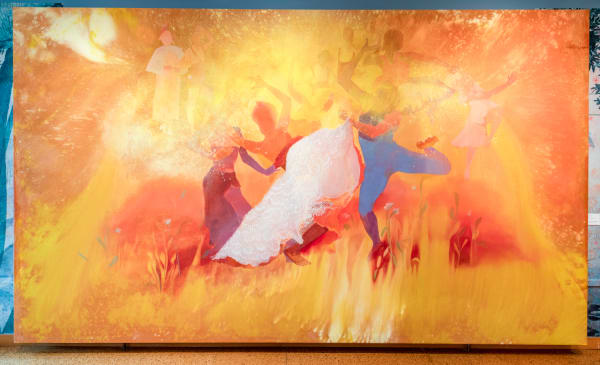Roger Brown
Aha! Heterosexuals Fuck Too, 1991
Oil on canvas
72 x 72 x 2 in
182.9 x 182.9 x 5.1 cm
182.9 x 182.9 x 5.1 cm
4884
This painting of NBA superstar Earvin “Magic” Johnson memorializes the moment, on November 7th, 1991, when Johnson stunned the world by publicly announcing he had tested positive for HIV. As...
This painting of NBA superstar Earvin “Magic” Johnson memorializes the moment, on November 7th, 1991, when Johnson stunned the world by publicly announcing he had tested positive for HIV.
As a heterosexual celebrity, Johnson broke new ground with his announcement, although LGBTQ+ celebrities coming forward (or being outed) for being HIV/AIDS positive was not an especially uncommon headline. Queer icon Freddie Mercury would die from AIDS-related pneumonia only 17 days after Johnson’s announcement, joining Rock Hudson (1985), Liberace (1987), Robert Mapplethorpe (1989), and Keith Haring (1990) who had already succumbed to the disease, and numerous others, including Brown (1997), whose lives it would claim in subsequent years.
With characteristic wit and poignancy, Brown’s painting pinpoints the hypocrisy of a society that at the time notoriously falsely pretended the HIV virus only infect members of the gay community and intravenous drug users.
The AIDS epidemic "officially" began in 1981 when the US Centers for Disease Control and Prevention identified unusual outbreaks of pneumonia among gay men in Los Angeles. A year later, the CDC published a further report proposing that a sexually transmitted infection may be the cause for related outbreaks nationwide. The condition was called “Gay-related Immune Deficiency” (“GRID”) in these early reports, ignoring data about straight people who were experiencing similar issues.
As the disease reached popular consciousness and became part of national discourse, the fixation on its pervasiveness in queer spaces dominated much of the dialog. Earning nicknames such as “The Gay Plague” and “Homosexual Syndrome” it was a common misconception throughout much of the 1980s that HIV/AIDS was exclusively transmitted between gay men. This misinformation was fueled by political positioning and in some instances, furor from religious zealots who proposed the epidemic was the result of God’s wrath.
Brown's treatment of the subject deftly satirizes such distractions, admonishing them as the sideshow spectacles that they are.
As a heterosexual celebrity, Johnson broke new ground with his announcement, although LGBTQ+ celebrities coming forward (or being outed) for being HIV/AIDS positive was not an especially uncommon headline. Queer icon Freddie Mercury would die from AIDS-related pneumonia only 17 days after Johnson’s announcement, joining Rock Hudson (1985), Liberace (1987), Robert Mapplethorpe (1989), and Keith Haring (1990) who had already succumbed to the disease, and numerous others, including Brown (1997), whose lives it would claim in subsequent years.
With characteristic wit and poignancy, Brown’s painting pinpoints the hypocrisy of a society that at the time notoriously falsely pretended the HIV virus only infect members of the gay community and intravenous drug users.
The AIDS epidemic "officially" began in 1981 when the US Centers for Disease Control and Prevention identified unusual outbreaks of pneumonia among gay men in Los Angeles. A year later, the CDC published a further report proposing that a sexually transmitted infection may be the cause for related outbreaks nationwide. The condition was called “Gay-related Immune Deficiency” (“GRID”) in these early reports, ignoring data about straight people who were experiencing similar issues.
As the disease reached popular consciousness and became part of national discourse, the fixation on its pervasiveness in queer spaces dominated much of the dialog. Earning nicknames such as “The Gay Plague” and “Homosexual Syndrome” it was a common misconception throughout much of the 1980s that HIV/AIDS was exclusively transmitted between gay men. This misinformation was fueled by political positioning and in some instances, furor from religious zealots who proposed the epidemic was the result of God’s wrath.
Brown's treatment of the subject deftly satirizes such distractions, admonishing them as the sideshow spectacles that they are.
Literature
Made when Magic Johnson came out as HIV positive, Brown wanted to acknowledge the heterosexuals can be positive too.
Share
- X
- Tumblr

